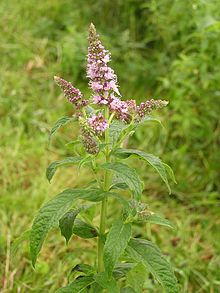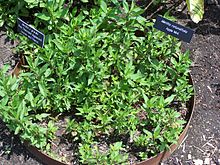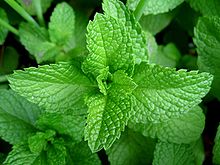 |
|
|
|
|
| Cuisines | Herbal | Spice | Curry | Yeast | Recipe | ||||||
|
Mint Mentha (also known as Mint, from Greek míntha, Linear B mi-ta) is a genus of flowering plants in the family Lamiaceae (mint family). The species are not clearly distinct and estimates of the number of species varies from 13 to 18. Hybridization between some of the species occurs naturally. Many other hybrids as well as numerous cultivars are known in cultivation. The genus has a subcosmopolitan distribution across Europe, Africa, Asia, Australia, and North America. Mints are aromatic, almost exclusively perennial, rarely annual, herbs. They have wide-spreading underground and overground stolons and erect, square, branched stems. The leaves are arranged in opposite pairs, from oblong to lanceolate, often downy, and with a serrate margin. Leaf colors range from dark green and gray-green to purple, blue, and sometimes pale yellow. The flowers are white to purple and produced in false whorls called verticillasters. The corolla is two-lipped with four subequal lobes, the upper lobe usually the largest. The fruit is a small, dry capsule containing one to four seeds. While the species that make up the Mentha genus are widely distributed and can be found in many environments, most Mentha grow best in wet environments and moist soils. Mints will grow 10–120 cm tall and can spread over an indeterminate area. Due to their tendency to spread unchecked, mints are considered invasive. Cultivation All mints prefer, and thrive in, cool, moist spots in partial shade. In general, mints tolerate a wide range of conditions, and can also be grown in full sun. They are fast growing, extending their reach along surfaces through a network of runners. Due to their speedy growth, one plant of each desired mint, along with a little care, will provide more than enough mint for home use. Some mint species are more invasive than others. Even with the less invasive mints, care should be taken when mixing any mint with any other plants, lest the mint take over. To control mints in an open environment, mints should be planted in deep, bottomless containers sunk in the ground, or planted above ground in tubs and barrels. Some mints can be propagated by seed. Growth from seed can be an unreliable method for raising mint for two reasons: mint seeds are highly variable - one might not end up with what one presupposed was planted; and some mint varieties are sterile. It is more effective to take and plant cuttings from the runners of healthy mints. The most common and popular mints for cultivation are peppermint (Mentha × piperita), spearmint (Mentha spicata), and (more recently) apple mint (Mentha suaveolens). Mints are supposed to make good companion plants, repelling pest insects and attracting beneficial ones. Mints are susceptible to whitefly and aphids. Harvesting of mint leaves can be done at any time. Fresh mint leaves should be used immediately or stored up to a couple of days in plastic bags within a refrigerator. Optionally, mint can be frozen in ice cube trays. Dried mint leaves should be stored in an airtight container placed in a cool, dark, dry area. Culinary Uses The leaf, fresh or dried, is the culinary source of mint. Fresh mint is usually preferred over dried mint when storage of the mint is not a problem. The leaves have a warm, fresh, aromatic, sweet flavor with a cool aftertaste. Mint leaves are used in teas, beverages, jellies, syrups, candies, and ice creams. In Middle Eastern cuisine, mint is used on lamb dishes, while in British cuisine and American cuisine, mint sauce and mint jelly are used, respectively. Mint is a necessary ingredient in Touareg tea, a popular tea in northern African and Arab countries. Alcoholic drinks sometimes feature mint for flavor or garnish, such as the mint julep and the mojito. Crème de menthe is a mint-flavored liqueur used in drinks such as the grasshopper. Mint essential oil and menthol are extensively used as flavorings in breath fresheners, drinks, antiseptic mouth rinses, toothpaste, chewing gum, desserts, and candies; see mint (candy) and mint chocolate. The substances that give the mints their characteristic aromas and flavors are menthol (the main aroma of Peppermint and Japanese Peppermint) and pulegone (in Pennyroyal and Corsican Mint). The compound primarily responsible for the aroma and flavor of spearmint is R-carvone. Mints are used as food plants by the larvae of some Lepidoptera species including Buff Ermine. Medicinal and cosmeticMint was originally used as a medicinal herb to treat stomach ache and chest pains, and it is commonly used in the form of tea as a home remedy to help alleviate stomach pain. In Rome, Pliny recommended that a wreath of mint was a good thing for students to wear since it was thought to "exhilarate their minds". During the Middle Ages, powdered mint leaves were used to whiten teeth. Mint tea is a strong diuretic.[citation needed] A common use is as an antipruritic, especially in insect bite treatments (often along with camphor). The strong, sharp flavor and scent of mint is sometimes used as a mild decongestant for illnesses such as the common cold. Mint is also used in some shampoo products. Menthol from mint essential oil (40–90%) is an ingredient of many cosmetics and some perfumes. Menthol and mint essential oil are also much used in medicine as a component of many drugs, and are very popular in aromatherapy. Menthol is also used in cigarettes as an additive, because it blocks out the bitter taste of tobacco and soothes the throat. InsecticidesMint oil is also used as an environmentally-friendly insecticide for its ability to kill some common pests like wasps, hornets, ants and cockroaches. Room Scent and AromatherapyKnown in Greek Mythology as the herb of hospitality, one of the first known uses for mint in Europe was as a room deodorizer. The herb was strewn across floors to cover the smell of the hard-packed soil. Stepping on the mint helped to spread its scent through the room. Today, it is more commonly used for aromatherapy through the use of essential oils. |











